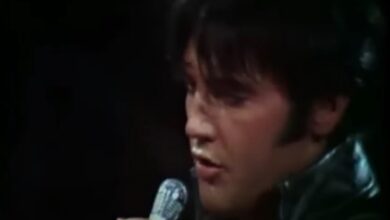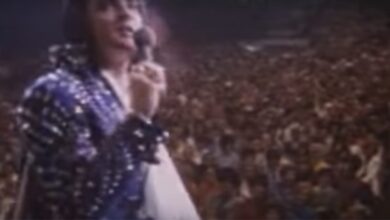The Performance Stirs Emotions Of Pride And Gratitude In The Audience As American Veterans
Sgt. Barry Sadler’s “Ballad of the Green Berets,” released in 1966, is not just a song but a resonant cultural artifact that highlights the experiences of U.S. Army Special Forces during the Vietnam War. It serves both as a tribute to the valiant sacrifices of these soldiers and as a reflection of the societal attitudes prevalent at the time. Written while Sadler was recuperating from a serious injury he sustained during combat, the lyrics capture his love for his comrades and his unwavering belief in their mission. This personal connection lent significant authenticity to the song, which many listeners could feel in its heartfelt lines.
Sadler’s life journey began in the small town of Carlsbad, New Mexico, where he faced numerous adversities, including family upheaval and the loss of his father at a young age. These early challenges may have ingrained in him a sense of resilience, leading him to join the U.S. Air Force initially. However, it was later his transition into the Army that allowed him to embrace the elite Green Beret training, positioning him to navigate the complexities of the Vietnam War. His experiences as a Green Beret, including the training, camaraderie, and the harsh realities of warfare, provided a rich tapestry of inspiration for his songwriting.
The backdrop of the Vietnam War was a turbulent one, with public sentiment increasingly shifting toward skepticism about the U.S. involvement overseas. “The Ballad of the Green Berets” emerged as a salve during this time of discord, offering a celebration of military valor at a moment when many soldiers faced hostility or indifference upon their return home. Rather than dwell on the grim aspects of war, the song focused on the nobility and brotherhood among soldiers, creating an atmosphere of honor and respect that resonated strongly with audiences.
Upon its release, “The Ballad of the Green Berets” quickly ascended to the top of the Billboard Hot 100 chart, where it held the number-one spot for five consecutive weeks. The commercial success of the song was astounding, illustrating a cultural moment in which patriotic expressions were buoyed by music. The popularity of the song transcended U.S. borders, with recordings in multiple languages showcasing its universal themes of courage and sacrifice, resonating with people in various nations who appreciated the sacrifices made by soldiers in wartime.
After his military service, Sadler ventured into the entertainment industry, aiming to build a career that would match the success of his singular hit. He dabbled in writing, acting, and even pursued a passion for literature, penning novels such as the “Casca” series which offered imaginative tales featuring an immortal Roman soldier. However, despite these efforts, he never achieved the same level of widespread acclaim as he did with his famous ballad, indicating the unique and profound impact that one song can have on an artist’s legacy.
Sadler’s life took several tumultuous turns in his later years. He became embroiled in legal issues and faced personal challenges that overshadowed his earlier triumphs. A near-fatal shooting incident in Guatemala left him severely injured and further complicated his post-military life, contrasting sharply with the pride and honor that “The Ballad of the Green Berets” had instilled in his image. The challenges he faced later reflect the often complex and difficult realities many veterans encounter after returning from the battlefield.
Barry Sadler passed away in 1989, yet his legacy remains intricately tied to his service as a Green Beret and the powerful emotions conjured by his music. “The Ballad of the Green Berets” continues to evoke feelings of pride, courage, and respect for those who serve in the armed forces, serving as a lasting reminder of the personal and collective sacrifices made during times of war. Through this anthem, Sadler managed to encapsulate not only his own experiences but also those of a generation navigating the uncertain waters of a conflict that left deep scars on the national psyche.
As the years have gone by, the song has found new life in various contexts, being played at memorial services, veteran celebrations, and on holidays such as Memorial Day and Veterans Day. Its lasting presence in American culture underscores the importance of acknowledging and honoring the sacrifices of military personnel, ensuring that their stories and struggles are not forgotten. In this way, Sadler’s song has evolved into a powerful symbol of remembrance and commemoration.
Reflecting on the enduring legacy of “The Ballad of the Green Berets,” it becomes clear that music has a unique ability to capture the hearts and minds of people, often becoming a vessel of collective memory. Sadler’s unique blend of personal narrative and patriotic fervor created a piece that transcends mere entertainment, reaching into the deeper currents of identity, honor, and the human experience in times of conflict. In preserving the memory of those who serve, Sadler’s ballad continues to resonate, reminding us of the profound connection between art, memory, and the values we hold dear as a society.
In the end, Barry Sadler’s journey—marked by both triumph and turbulence—reflects the complexities of the veteran experience, one that is often defined by courage, camaraderie, and an undeniable quest for meaning amidst the chaos of war. Just as his ballad stands the test of time, so too do the stories and sacrifices of soldiers who served, inviting future generations to pause, reflect, and honor the legacy of those who wore the uniform.
&ab_channel=WhenTheCowboySings





